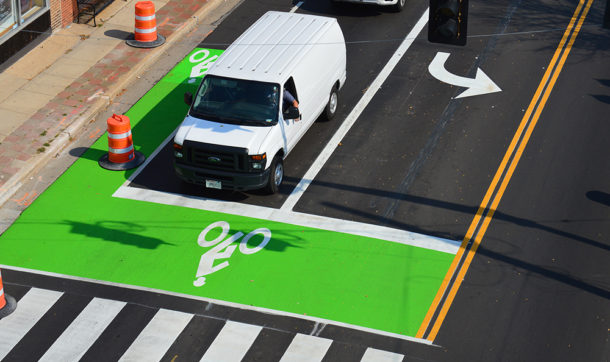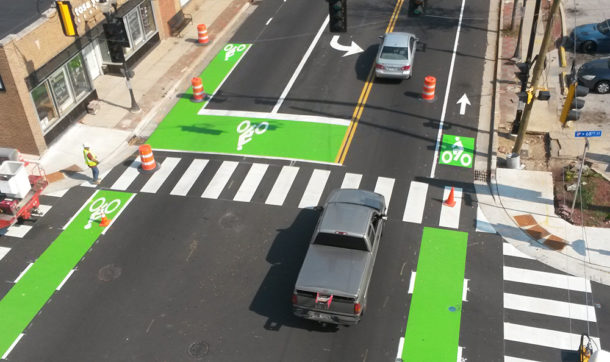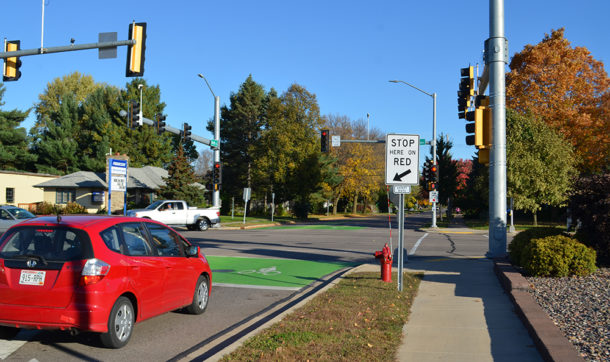Bike Boxes Boost Bicyclist Visibility, Safety

Bike boxes are relatively new on-pavement markings that provide a place in front of the vehicular stop line for bicyclists to queue up at a red light, giving them visibility and priority in moving through the intersection upon the light turning green. The boxes increase safety by getting bikes through the intersection before vehicular traffic attempts to overtake them.
Some bike boxes are set up in straight-through and right-turn lanes only, while others allow bicyclists to queue up in front of the left-turn lane too.
How and Where Bike Boxes Help Cyclists
The main benefits of marking certain intersections with bike boxes include increasing bicyclists’ visibility, confidence, and ultimately safety in crossing through intersections that otherwise pose perceived or actual safety threats.
The visibility factor involves putting bicyclists in front of vehicles at a red light, thus making drivers aware of their presence – much more so than if bicyclists wait near the curb to the right of motorized traffic. In places where truck traffic is high, bicyclists queued on the right are particularly hidden from drivers in high truck cabs, the National Association of City Transportation Officials (NACTO) Urban Bikeway Design Guide points out. Right-hook crashes are a significant problem for bicyclists when drivers to their immediate left don’t see them and make a right turn, hitting or cutting off the bicyclist.
Bike boxes are most appropriate where bicycle traffic is being encouraged or already is heavy. They are best placed at signalized intersections with moderate traffic flows and a relatively simple lane designation. Putting bicyclists front-and-center at an extremely busy and complex intersection might put them at risk in their long trek through such an intersection.
Studies that Support the Effectiveness of Bike Boxes
Portland, Oregon, was the first city in the United States to introduce large-scale bike box installations, implementing 12 boxes throughout the City’s center in 2008. The bike boxes allow bicyclists to position themselves to go straight or turn right but not to turn left. The bike boxes were greeted positively by drivers and bicyclists, compliance was high among both groups, conflicts dropped, yielding increased, and encroachment of traffic on crosswalks was reduced, according to the Oregon Transportation Research and Education Consortium’s January 2011 “Evaluation of Bike Boxes at Signalized Intersections” report.
Another community that implemented and then studied bike boxes is Austin, Texas. This study looked at the behavior of drivers and bicyclists at two intersections where new bike boxes were installed for the intended benefit of bike traffic that largely continues straight through the intersections. Like the Portland study, this one looked at bike boxes that did not accommodate left turns by bikes.
“The results of this study show that bicycle boxes accompanied with ‘No Right Turn on Red’ signs can improve the safety of bicyclists and motorists at intersections,” the City of Austin Bicycle Team stated in its report, “Effects of Bicycle Boxes on Bicyclist and Motorist Behavior at Intersections.” The study observed that drivers gave bicyclists the right-of-way more often with the presence of bike boxes, with a significant increase in the percentage of bicyclists departing the intersection first when the light changed to green – ahead of vehicular traffic.
Design and Signage
Bike boxes typically are installed where bike lanes exist. Leading up to the right side of the bike box is a marked ingress area that connects the bike lane to the bike box, leading bicyclists visually into the bike box. This marked bicycle approach area typically ranges in length from 25 to 50 feet.
 The NACTO Bikeway Design Guide calls for 10- to 16-foot-deep bike boxes. The Austin report garnered feedback from the public indicating an 8-foot depth was insufficient for bikes to maneuver within the box. The width of a bike box extends across some or all of the vehicular approach lanes.
The NACTO Bikeway Design Guide calls for 10- to 16-foot-deep bike boxes. The Austin report garnered feedback from the public indicating an 8-foot depth was insufficient for bikes to maneuver within the box. The width of a bike box extends across some or all of the vehicular approach lanes.
“Further, public feedback has suggested extending the bicycle box across multiple lanes to accommodate left-turning bicyclists,” the Austin report states. “Although the sites observed in this study did not have high volumes of left-turning bicyclists, other intersections in the city often do, so additional research into extending the bicycle box into the left-turn lane would have merit.”
Bike boxes at North Avenue and 68th Street in Wauwatosa, Wisconsin, designed by Ayres Associates and installed in 2014, accommodate all bike movements, including left turns. Bicyclists can position themselves ahead of the vehicular left-turn lane, in front of the vehicular through lane, or in the bike lane for either a right turn or a through movement.
The bicycle symbol is placed in the center of the bike box area to alert motorists and bicyclists that the area is reserved for use by bicyclists. Multiple bike symbols could be placed in the bike box, each showing bicyclists the ideal spot to wait to command the left-turn, straight-through, or right-turn lane. Such bicycle symbol placement also might indicate the optimal spot to wait to trip the system that prompts the traffic signal to cycle to green.
A stop line is placed behind the bike box to indicate the point behind which vehicles are required to stop in compliance with a red traffic signal. In some cases a message such as “Wait Here” is also painted on the pavement behind the stop bar to reiterate to motorists where they should queue on red.
 Adequate and appropriate vertical signage is also necessary to educate the traveling public on the correct usage of bike boxes. An R10-6A (Stop Here on Red) sign can be installed near the stop bar to define the location where motorized vehicles should stop, which is behind the bike box at the stop bar. When issues exist where right-turning vehicles often conflict with bicyclists, it is common for an R10-11 (No Turn on Red) sign to be installed to restrict right turns on red. Using bike boxes to put bicyclists in front of traffic, along with enforcement of the no-turn-on-red regulation, can reduce right-hook crashes.
Adequate and appropriate vertical signage is also necessary to educate the traveling public on the correct usage of bike boxes. An R10-6A (Stop Here on Red) sign can be installed near the stop bar to define the location where motorized vehicles should stop, which is behind the bike box at the stop bar. When issues exist where right-turning vehicles often conflict with bicyclists, it is common for an R10-11 (No Turn on Red) sign to be installed to restrict right turns on red. Using bike boxes to put bicyclists in front of traffic, along with enforcement of the no-turn-on-red regulation, can reduce right-hook crashes.
Looking for more information? Reach out to any of our traffic engineering experts!
Comments
Bike boxes
Excellent idea!

Post a comment: